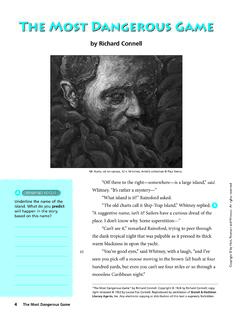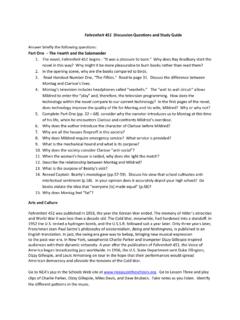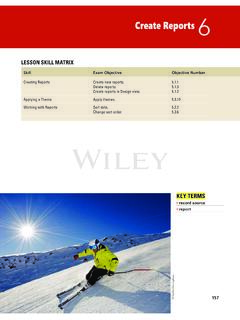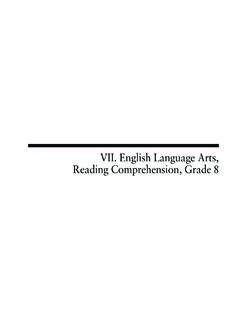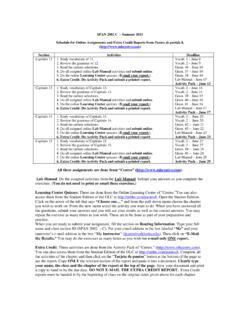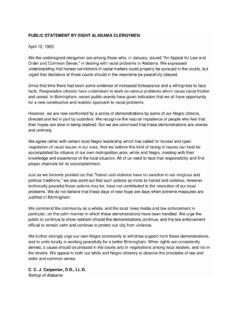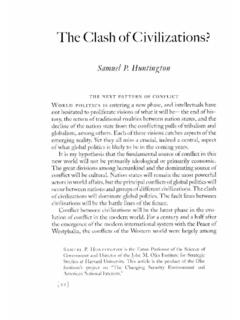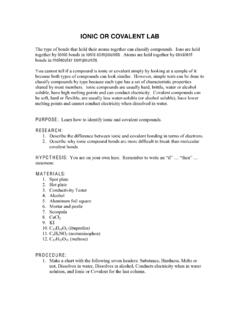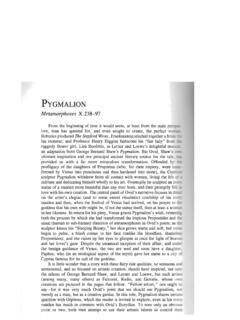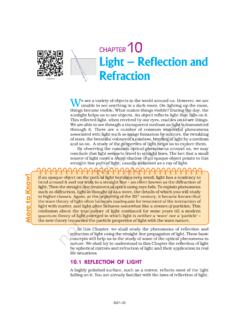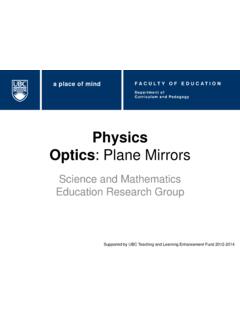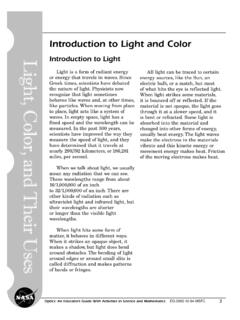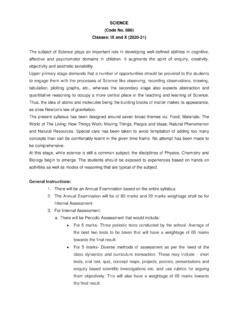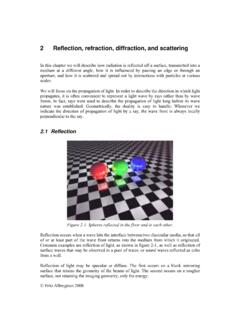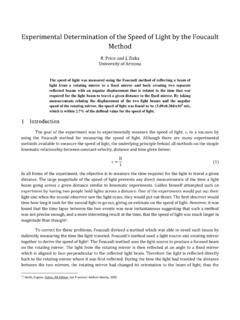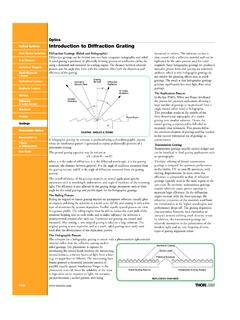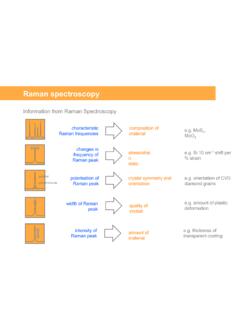Transcription of Physics I Notes Chapter 14: Light, Reflection, and Color
1 Page 1 of 8 Physics I Notes Chapter 14: light , Reflection, and Color Characteristics of light light is an electromagnetic wave. As shown below, an electromagnetic wave is a transverse wave consisting of mutually perpendicular oscillating electric and magnetic fields. Electromagnetic waves are ultimately produced by an accelerating charge. A changing electric field produces a changing magnetic field which in turn produces a changing electric field and so on. Because of this relationship between the changing electric and magnetic fields, an electromagnetic wave is a self-propagating wave that can travel through a vacuum or a material medium since electric and magnetic fields can exist in either one. Animation of wave with vibrating charge Scroll down after webpage loads for animation. All electromagnetic waves travel at the speed of light .
2 Electromagnetic waves are distinguished from each other by their differences in wavelengths and frequencies (wavelength is inversely related to frequency). c=f c = speed of light = x 10 8 m/s in a vacuum = 300,000 km/s = 186,000 miles/s A light year is the distance that light travels in one year in a vacuum. So haw many miles would that be? What would a light -minute be? The electromagnetic spectrum is a continuum of all electromagnetic waves arranged according to frequency and wavelength. Visible light is only a small portion of the entire electromagnetic spectrum. Page 2 of 8 Brightness or intensity of light decreases by the square of the distance from the source (inverse square law).. Question: How much would the brightness change if you were 3 times farther away from the source as your classmate?
3 Everything you is light ! You do not see people or objects - you only see the light they reflect!! Ray model of light Waves are often approximated as rays to predict the path with which they will travel. The ray model of light is based on the assumption that light travels in a straight line in a vacuum or uniform medium. A ray is a straight line that represents the path of a very narrow beam of light . Ray diagrams are drawings used to depict the path of light rays. Even though ray diagrams ignore the wave nature of light , they are useful in describing how light behaves at boundaries (reflection or refraction) and often used to locate the image formed by a mirror or a lens. Behavior of light at a boundary Whenever light (or any wave) encounters a different medium one of three things can happen. The light can be absorbed by the new medium and turned into internal energy and/or heat, the light can be transmitted through the new medium, or the light can be reflected back into the original medium.
4 In reality, what most often happens is a combination of the three fates. Good mirrors reflect about 90 percent of the incident light and absorb the rest. If the light is reflected the angle of the reflected ray will be equal to the angle of the incident ray. If the ray is transmitted into the new medium the ray may be bent or refracted. We will focus on reflection this Chapter and on refraction next Chapter . When light encounters Matter The 3 possible fates to befall the energy of the light when it interacts with matter/substances: 1. Reflected Reflection of the light bounces the energy back into the same medium that it came from. 2. Transmitted through The light can travel through the new material while undergoing varying degrees of interaction with the substances molecules. 3. Absorbed The light energy can be completely absorbed into the molecules of the substance and turned into heat.
5 We can categorize substances according to how light interacts with that substance s molecules. Opaque objects absorb and/or reflect all light - light cannot get through. Transparent objects allows light to travel through in straight lines. Objects can be transparent to some colors or frequencies of light and opaque to others. Regular standard glass is transparent to visible light , but is opaque to UV and IR light . Translucent substances or objects scatter light in all directions as it passes through. Our atmosphere is translucent to visible light . Page 3 of 8 Reflection Reflection is the turning back of an electromagnetic wave at the surface of a substance. The Law of Reflection states that the angle of incidence = angle of reflection. Typically the angles are measured with respect to the normal. The normal is a line drawn perpendicular to the surface at the point of incidence.
6 Reflection of rays off a surface will be regular or varied depending on the size of the irregularities of the surface relative to the wavelength of the light incident on the surface. Specular (regular) reflection occurs when light is incident on a smooth surface and the rays are reflected parallel to each other. Diffuse reflection occurs when light is incident on a rough surface and the rays are reflected in many different directions. mirrors In analyzing mirrors we will focus on the types of images they produce. Images are formed at the point where rays of light actually intersect (real image) or from which they appear to intersect or come from (virtual image). Three characteristics are used in describing the image produced by a mirror 1. real or virtual, 2.
7 Orientation (inverted or upright), and 3. magnification (larger, smaller, or same size). Virtual images will be upright and real images will be inverted. Magnification is the ratio of the height of the image to the height of the object, which can also be calculated in terms of a ratio of the distances. If the image is larger than the object, the magnification will be greater than one. If the image is smaller than the object, the magnification will be less than one. If the image is the same size as the object, the magnification will be one. oioiddhhM == Page 4 of 8 Flat mirrors A flat mirror will always produce an upright, virtual, unmagnified image, that is left-right reversed. The distance from the object to the mirror is equal to the distance of the image to the mirror. Spherical mirrors The type of image produced by a spherical mirror depends upon whether the mirror is concave (converging) or convex (diverging) and, for concave mirrors , whether the object is behind or in front of the focal point.
8 The focal point is the point at which rays parallel to the principal axis intersect (converge) after being reflected. The principal axis is a line drawn perpendicular (normal) to the surface of the mirror and passes through the focal point and center of curvature of the mirror. Focal length is the distance from the focal point to the mirror along the principal axis. The focal length is the radius of curvature of the mirror. f=R/2 Images produced by spherical mirrors To determine the type of image produced by a spherical mirror you can draw ray diagrams and/or use the mirror and magnification equations. You will have to know how to do both. Four rules for finding images formed by spherical mirrors using ray diagrams. (Note You only need to draw two rays to determine the point at which the image will form.)
9 1. Incident rays parallel to the principal axis of a mirror are reflected through the focal point. 2. Incident rays that pass through the focal point are reflected parallel to the principal axis. 3. Incident rays that pass through the center of curvature are reflected back through the center of curvature. 4. Incident rays drawn to the point of contact of the principle axis with the mirror will reflect at the same angle with which they hit (law of reflection). Page 5 of 8 Equations used for locating images and determining magnifications Mirror equation Magnification fddio111=+ oioiddhhM == Sign conventions for mirrors do is + (object is in front of mirror) di is + if in front of mirror (real image) di is if behind mirror (virtual image) r and f are + for concave mirror r and f are for convex mirror M is positive, upright M is negative, inverted In this course -Virtual images are always upright.
10 Since the distance for a virtual image is negative, the magnification will be positive and the image is upright. Real images are always inverted. Since real images have a positive distance, magnification will be negative and the image is inverted. Concave (converging) mirrors The type of image produced by a concave mirror depends upon the location of the object relative to the focal point and center of curvature. Real images are formed if the object is beyond the focal point. a. All incoming rays parallel to the axis will reflect through the focal point. b. If the object is beyond the center of curvature, the image is inverted, real, and smaller. c. If the object is at C, the image will be real, inverted and the same size located also at C. d. If the object is between the focal point and center of curvature, the image is inverted, real, and larger.
